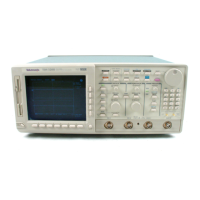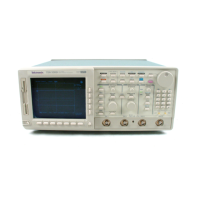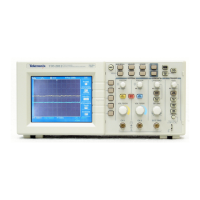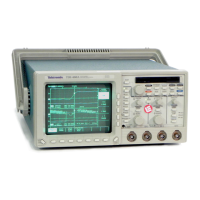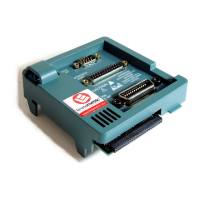Measuring Waveforms
3–138
TDS 500D, TDS 600B, & TDS 700D User Manual
To display measurement statistics, obtain a stable display of the waveform to be
measured. Then do the following steps:
1. Press MEASURE ➞ Measure (pop-up) ➞ Statistics (main) ➞ Statistics
Min/Max or Statistics Mean/StdDev (side).
Statistics Min/Max — Display the minimum and maximum statistics for
measurements.
Statistics Mean/StdDev — Display the mean and standard deviation
statistics for measurements.
2. To set the number of measurements included in the measurement statistics,
press MEASURE ➞ Measure (pop-up) ➞ Statistics (main) ➞ Statistics
Weights (side). Then enter the number of measurements to include in the
measurement statistics using the general purpose or the keypad.
3. To turn off measurement statistics, press MEASURE ➞ Measure (pop-
up) ➞ Statistics (main) ➞ Statistics Off (side).
To perform a tutorial that shows you how to take automatic measurements, see
Example 3: Taking Automated Measurements on page 2–22.
To learn how the oscilloscope calculates each automatic measurement, see
Appendix B: Algorithms on page B–1.
Taking Cursor Measurements
The TDS Oscilloscope provides cursors that measure the difference (either in
time or voltage) between two locations in a waveform record. This section
describes cursors — how to select their type and mode, how to display them, and
how to use them to take measurements.
Cursor measurements are fast and easy to take. Cursors are made up of two
markers that you position with the general purpose knob. You move one cursor
independently or both cursors in tandem, depending on the cursor mode. As you
position the cursors, readouts on the display report and update measurement
information.
To Find More Information

